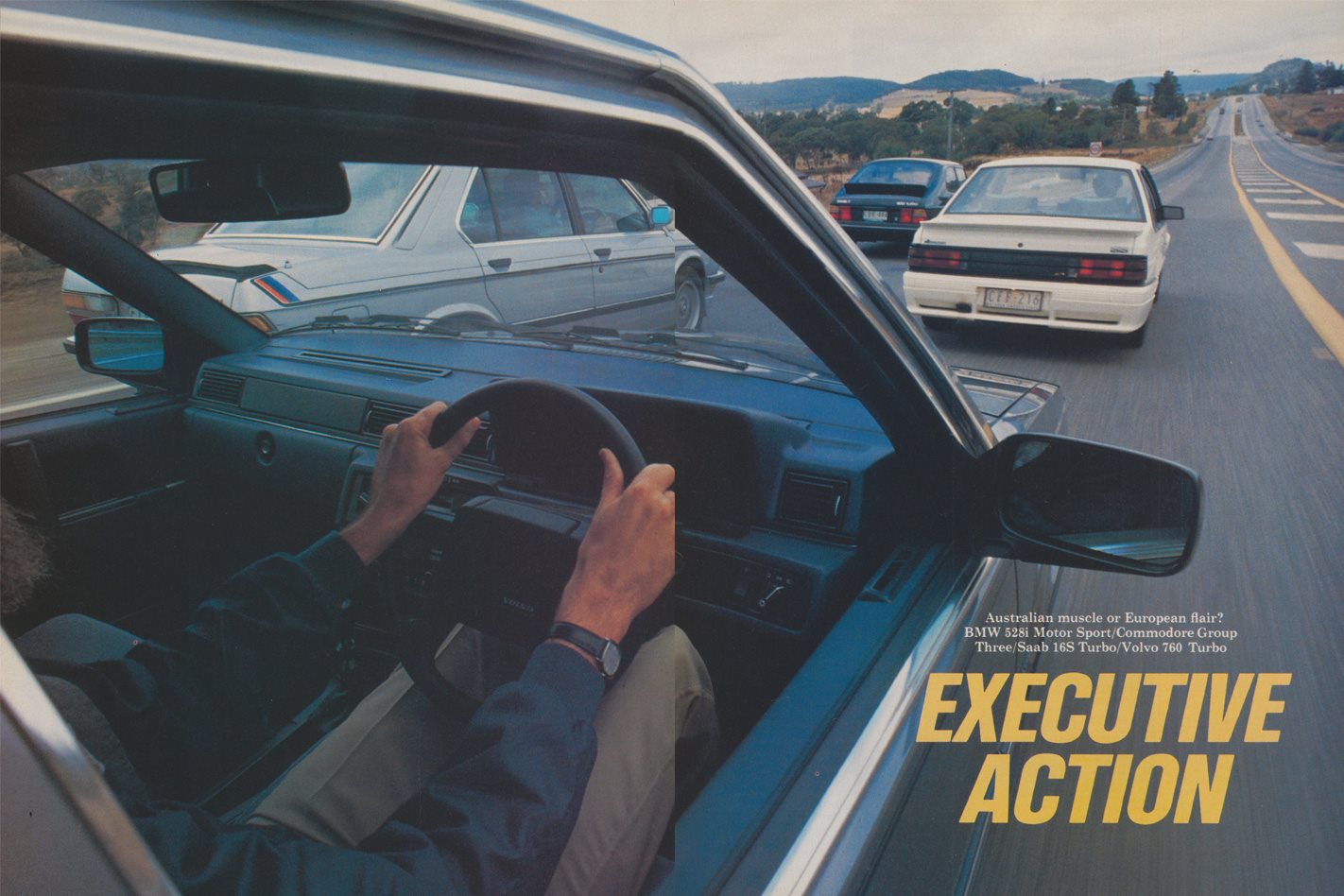IF YOU were to survey the covers of WHEELS and Australia’s other motoring magazines over the past two years you would find that Peter Brock’s HDT Commodores captured more covers than any other single car maker.
The interest in the cars and operations of what has been called Australia’s sixth largest car maker have become legendary in their ability to attract readers, and the Group Three Brockmobile has been the subject of more lyrical drive stories than any Ferrari.
Yet there is a lingering doubt that suggests the car might not be quite as right and proper as these solo tests would make out. The sceptics among you have been asking us to compare the Group Three with the latest breed of hot-shoe European sedans to satisfy their curiosity and even save them big dollars. Can the Brock car really be an adequate, and cheaper, substitute for a BMW?
This comparison set out to prove the point one way or the other and, in so doing, to discover the truth about the ultimate Commodore on the blacktop of Australia. Ranged against Australia’s Own muscle car we gathered the BMW 528i Motor Sport, the Saab Turbo 16S and the Volvo 760 Turbo. A thoroughly representative collection of the fastest sedans Europe has to offer.
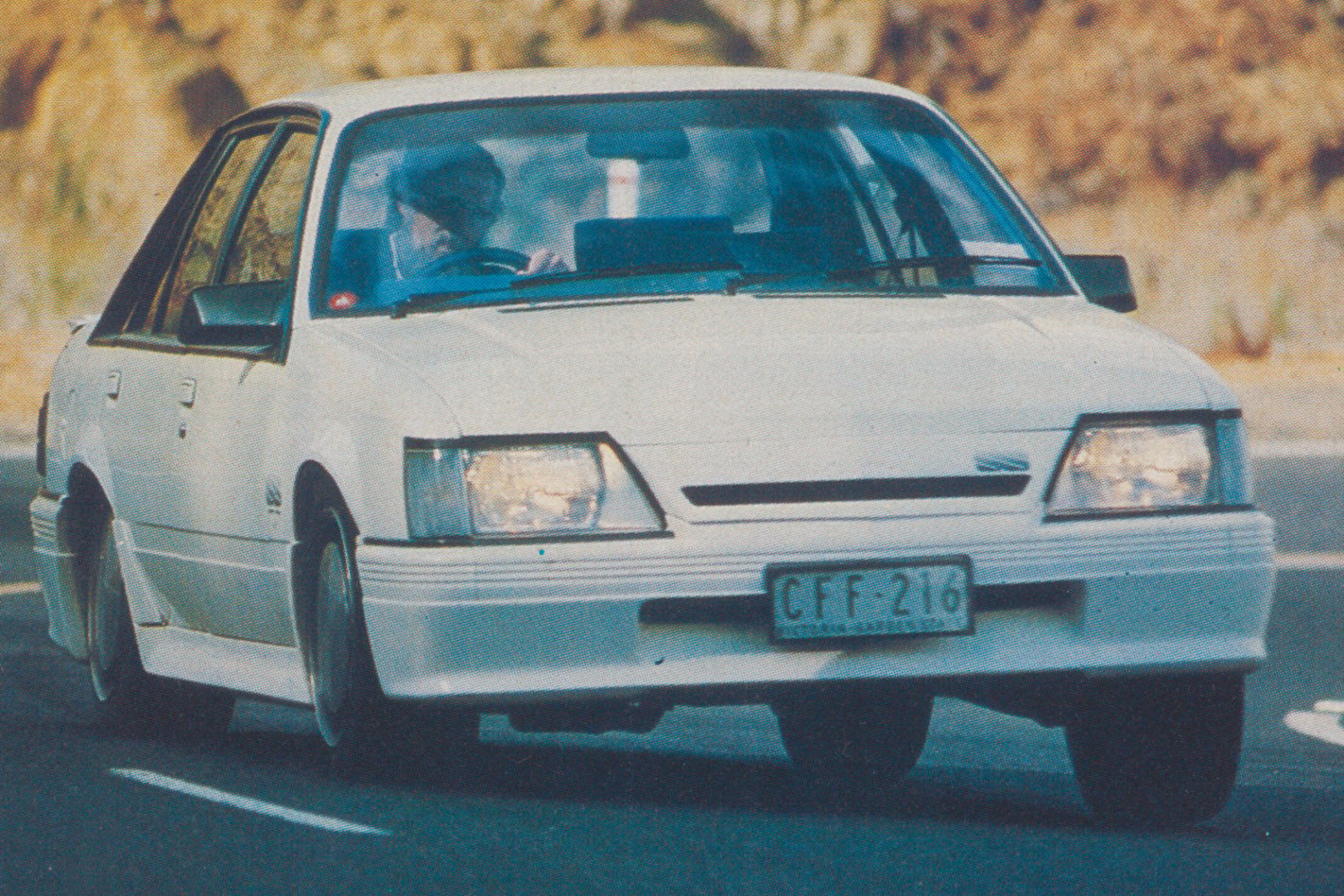
Holden’s decision to extend the life of the V8 engine ensures that we will see Brockmobiles until the end of the ’80s while the soon to be revealed 4.9 litre version allows the car to compete in International Group A racing. In its present form the BMW Five-series has been around since late ’81, although it clearly owes its heritage to the less refined, and yet seemingly identical looking, 525/528 models from the middle ’70s. As the middle model in BMW’s vast line-up, the 528i has been overshadowed in recent times by the Three-series, however the marque’s higher profile on the local scene has meant that general awareness of BMW has never been greater.
The Motor Sport version – the conversion takes place at Frank Gardner’s JPS operation – is mechanically identical to the five speed sedan but it has the apparently mandatory bolt-on cosmetics of spoilers front and rear, stripes and Mahle alloy wheels, while the factory options of three spoke steering wheel, heavily bucketed Recaro front seats, ABS braking, limited slip diff, firmer springs and gas dampers are standard.
Saab’s Turbo 16S is an aero by any other name and as the third generation in Saab’ s long-time affair with the turbo guarantees prodigious performance in a package that dates back to the late ’60s, although it has been subjected to more nose and tail lifts than any car we can think of. The only one of our quartet with front-drive, the 16S was also the only car with two doors and a hatchback body, so even in these basic areas of specification its strong character shone through. This is not a car for the conformist.
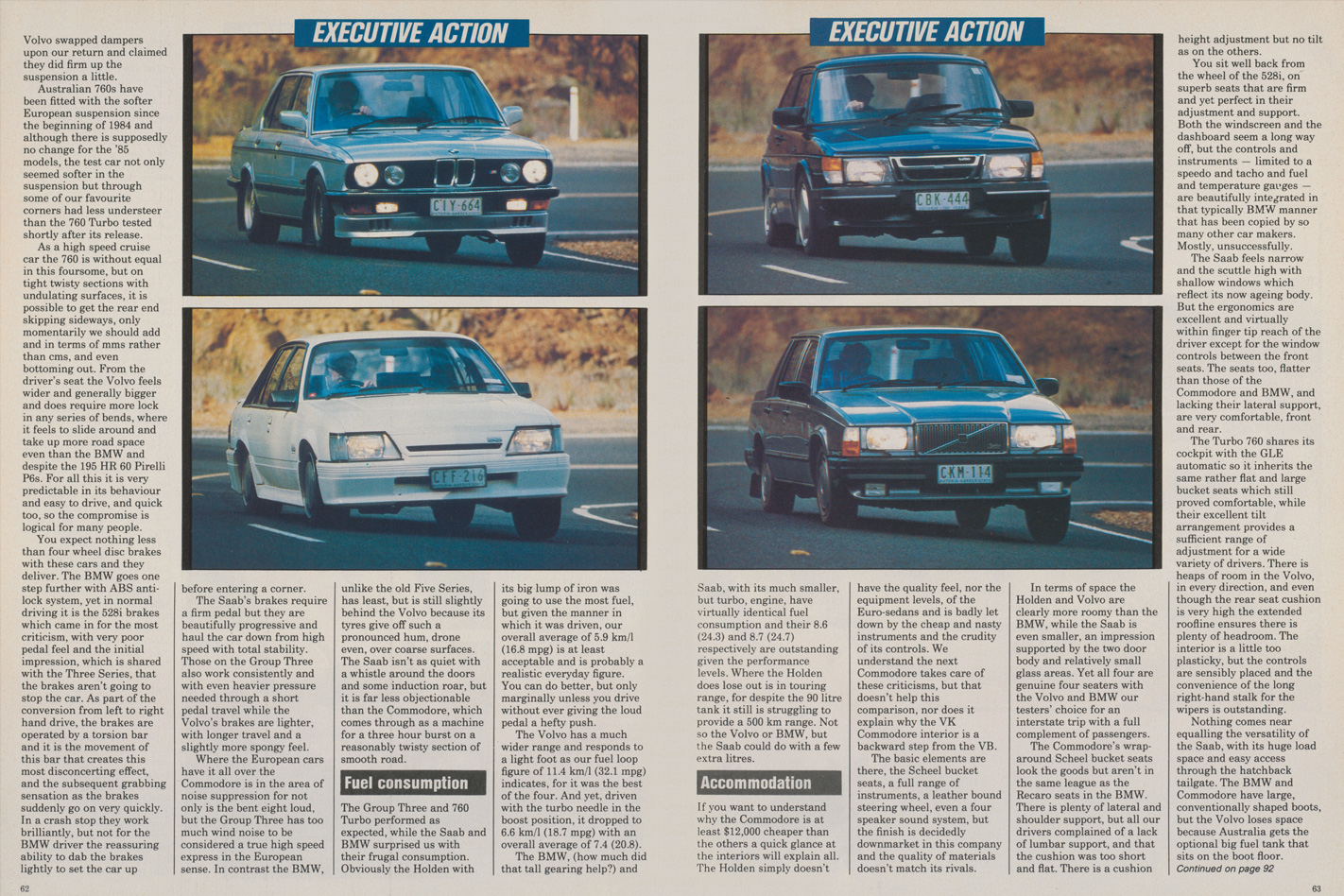
Prices, equipment
The made in Australia tag really means something in this territory, for the Holden, high priced though it is by Commodore standards, is little more than half the price of the imports, which suffer the penalty of a 57.5 percent import duty.
You can buy a Commodore SS for $18,865, but that is a basic SL with manual gearbox and five-litre engine. The go-faster bits and Group Three modifications are another $5770. For that money you get Bilstein strut inserts and dampers, heavy duty anti-roll bars front and rear, the Pirelli P7 225/60 16 tyres, a special exhaust and 90 litre fuel tank. The cosmetic changes include the front air dam, revised grille, skirts, rear spoiler and decals. Inside there is an improved quality carpet, a burglar alarm system and Momo wheel.
Automatic versions are offered in something called the Calais Director, which is essentially a Calais with the high performance engine and suspension kit, and at $5355 is more refined and quieter than the manual Group Three. The point with the HDT organisation is that it can (and will) build a Commodore to individual specification.
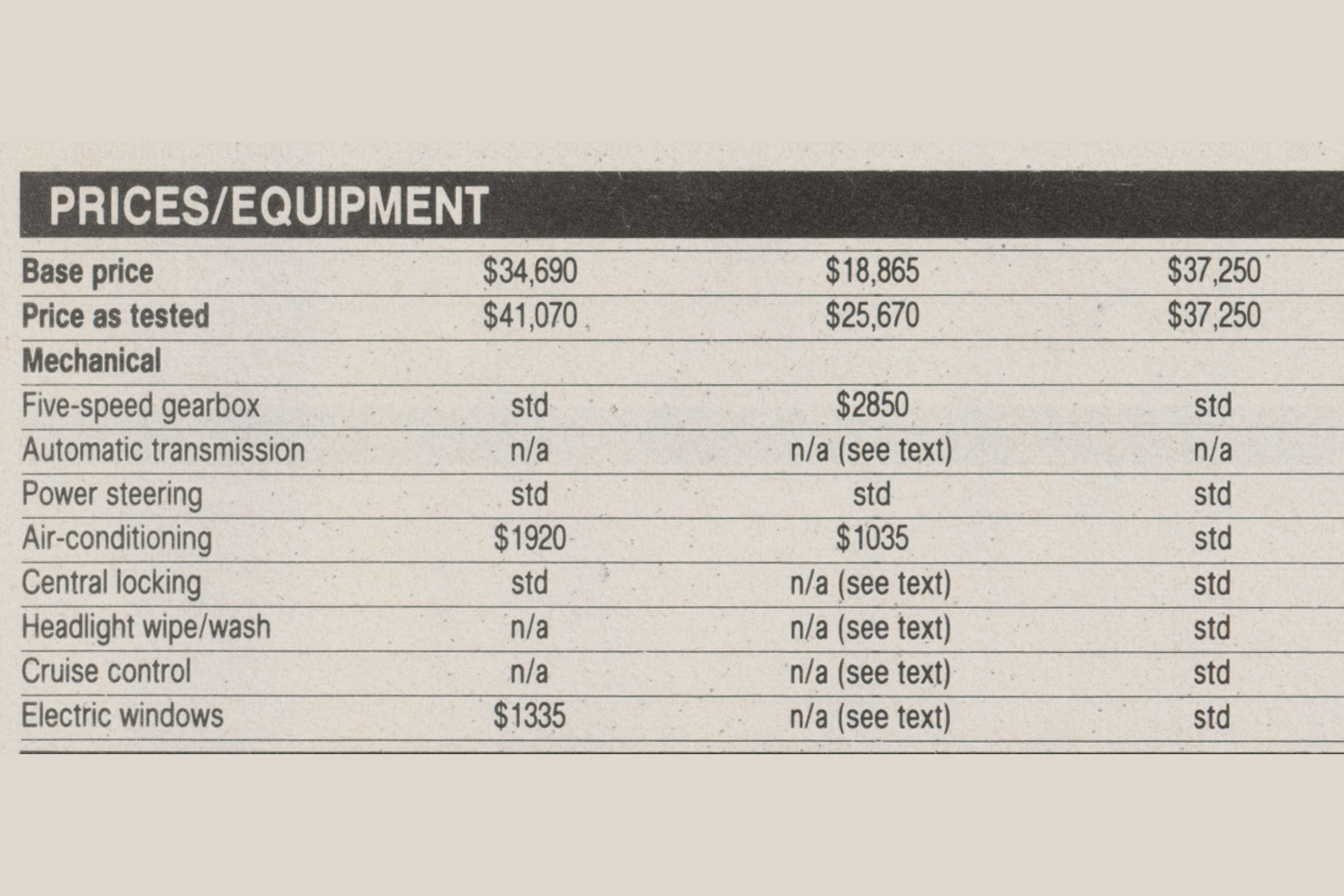
Going by base price the 528i is the next most expensive at $34,690 but the Motor Sport Kit takes it to $39,150, air conditioning is another $1035, for a total of $41,070 on the test car and a higher price than either the Saab’s $37,250 or the Volvo’s $38,540. Neither Swede came with options; none, really, were needed, so complete are their standard fittings.
So, for the Euro-sedans, the prices are close enough that they are not going to make any difference to one’s decision, while the Holden is far cheaper but doesn’t, of course, carry the prestige or the image except among the street machine crowd who know it for the fastest accelerating four door sedan any new car buyer can find.
Performance
Can European sophistication outgun sheer cubic inches? On paper there is no contest, the grunt of the five-litre bent eight has it all over the others as the standing 400 m times prove. The Brockmobile puts down 14.9 second times first time out, then the clutch begins to slip and the driver finds it impossible to duplicate this time, settling back to consistent 15.2/15.3 second runs. The Saab is one of those cars in which the performance figures fail to establish just how quick it is, especially at the top end, so its 400 m time of 15.9 sec says little of this car’s enormous potential in those speed ranges which are illegal in all states except the Northern Territory.
Not that the BMW or the Volvo could ever be regarded as slouches. The 528i takes just 16.1 sec and the 760Turbo 16.3 sec for the 400 m and both, especially the BeeMmm, are easier off the line than the others.
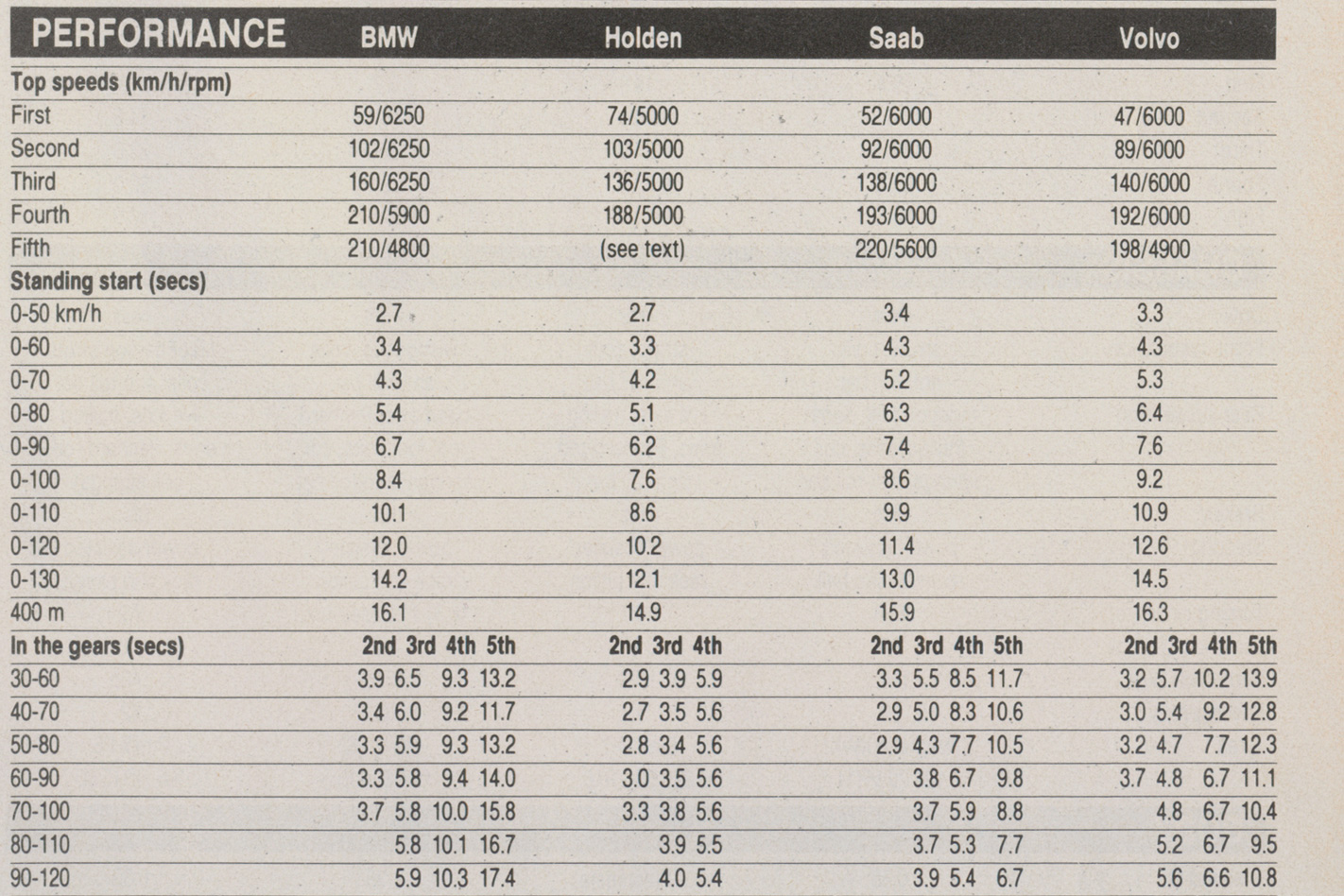
There is nothing sophisticated about the Holden’s power delivery: it relies on capacity for its staggering performance and is neither quiet nor smooth.
Fan and rocker gear noise are always present and the deep bellow that is so beautifully apparent from outside the car barely intrudes over the engine’s clatter and whine inside.
More disappointing is a mild drive train vibration under hard acceleration. These aside; however, there is no denying the Group Three has power in every situation, and can be ambled around in fourth gear down to less than 1500 rpm and still pull as strongly as its rivals do in third gear. First gear in the Holden is high and yet fourth (top gear remember) is surprisingly low, certainly by the standards of the other three cars which all feature overdrive fifth gears. The 5000 rpm redline can be ignored for there is another 500 rpm in hand if required, as it must be if the Group Three is to have a competitive top speed. At 5000 it is doing 188 km/h.
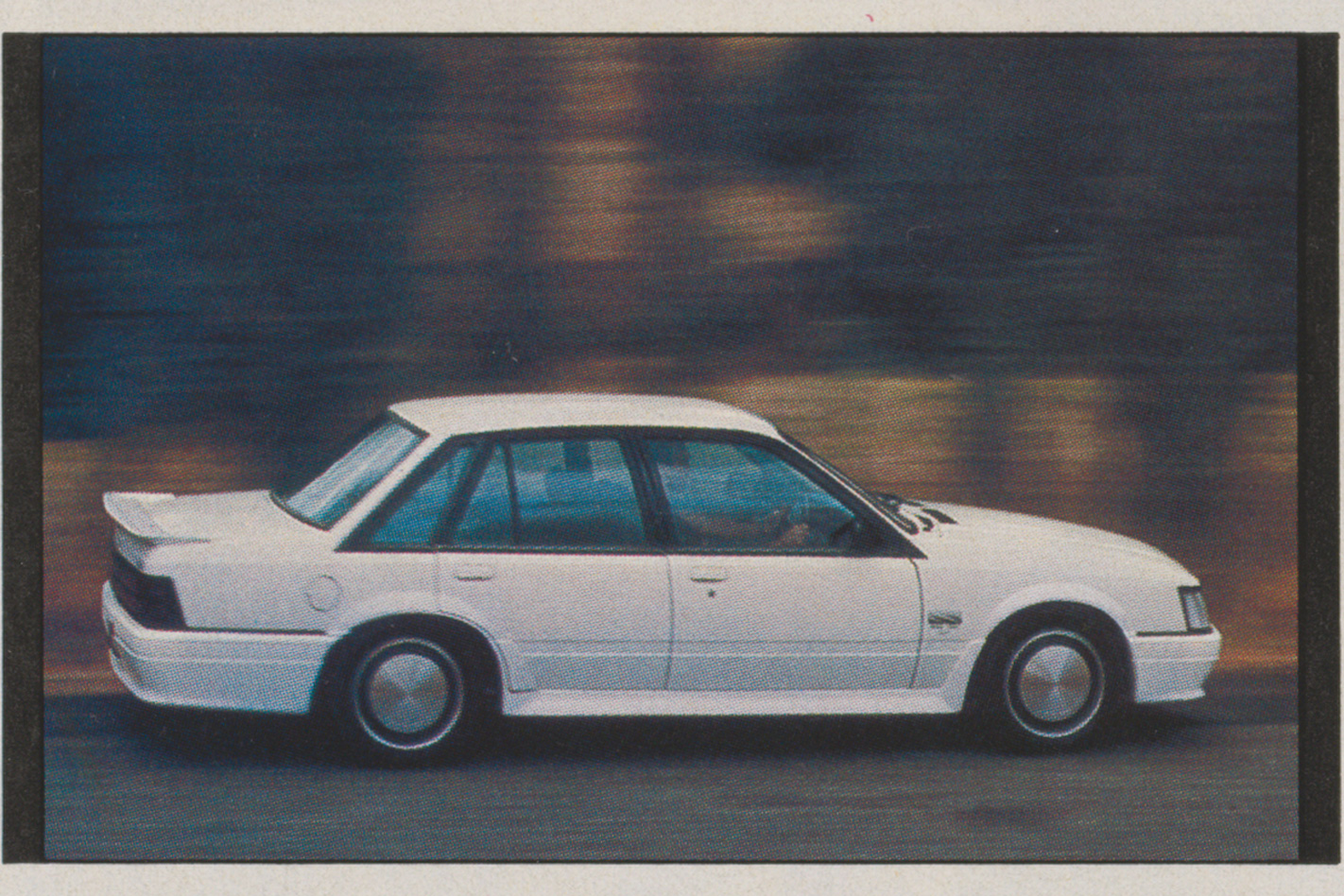
Once the Saab is off the line and running it is a superbly responsive car from 2000 rpm to the 6000 rpm redline. The 16-valve twin cam engine is far superior to the old eight-valve turbo unit at low speeds and while there is some turbo lag below’2000 rpm the feeling is exaggerated by the enormous power once the turbo begins to function. The Volvo, too, needs two grand on the tacho before it begins to pull strongly, but it never feels as agile to the throttle as the Saab, partly because it has a very long accelerator travel and also because the Saab has a superior power to weight ratio. This is in ultimate terms of course, for the Volvo is responsive and eager and really performs from 3000 rpm in the electrically operated fifth gear (it was called overdrive on the ’84 models) that is controlled by a button on top of the gear lever. Second gear is on low side and the gap to third rather wide, yet the other ratios are ideal.
The Volvo four, despite the years of development, is not as smooth as the Saab and becomes a little harsh from 5500 to the 6000 rpm redline. Even so, this is one of those cars that never feels as quick as the figures indicate, if only because it lacks the turbo urgency of the Saab.
For sheer smoothness, however, it is the 2.8 litre BMW six that sets the standard. Not that it is an engine that enjoys ambling along at low revs. No, like most German cars this Munich machine wants to spin fast and cruise at over 200 km/h on the autobahn. There is very little power below 2000 rpm and you really need all of 3500 before it starts to deliver the goods.
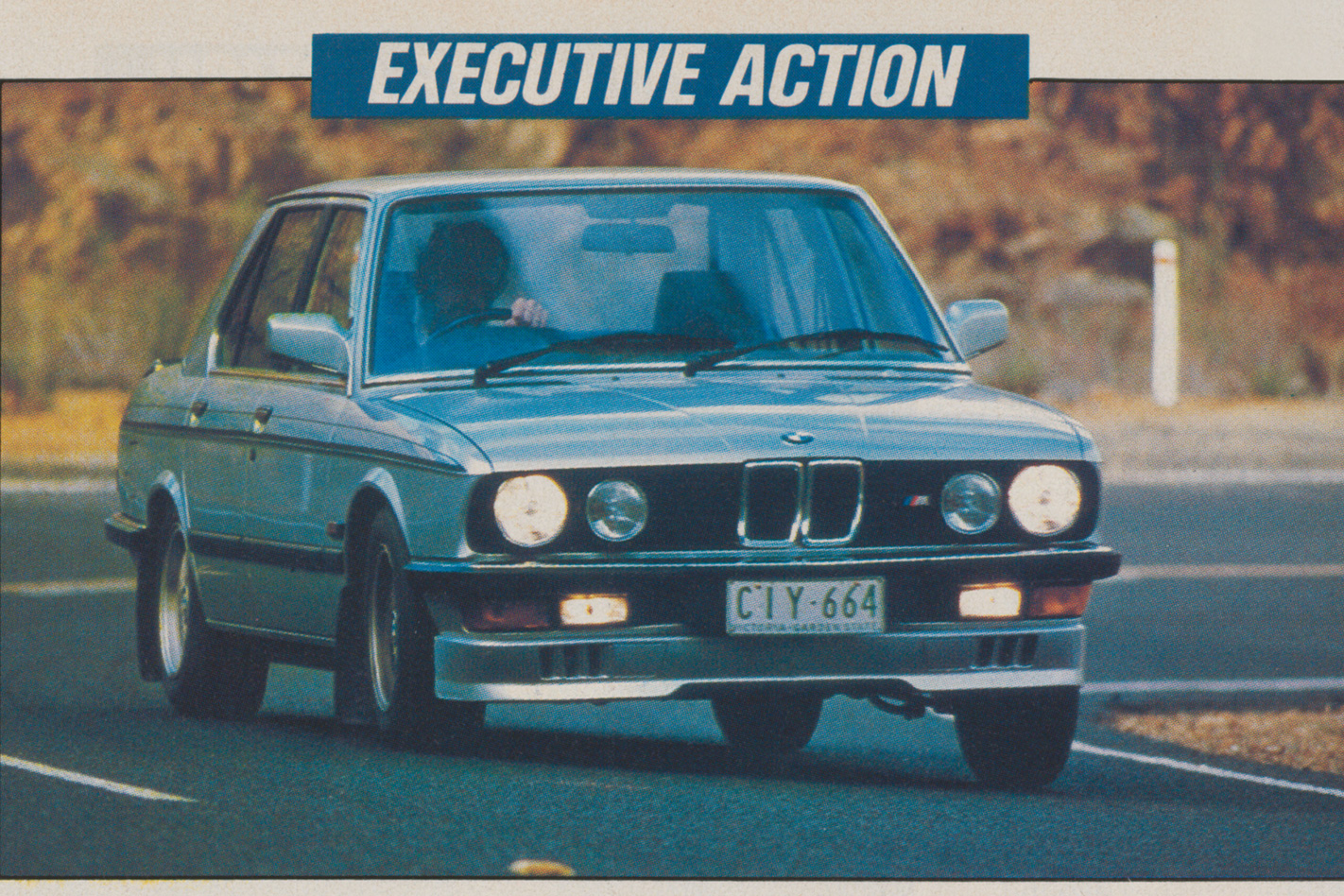
After driving the cars and completing our specification charts we realised something didn’t quite add up when cross referencing gear speeds on the road and the theoretical maximums. Upon investigation we discovered that late last year the 528i’s final drive ratio was changed from 3.25 to 3.45 and that our test car was fitted with the old ratio that gave 44.0 km/h per 1000 rpm in fifth, compared to the current car’s 41.4 km/h. The difference is not great – at 110 km/h in the test car the engine was pulling 2500 rpm while the ’85 model would be doing almost 2700 rpm – but would certainly improve general flexibility. Even so that’s still so far down the engine’s rev range that fifth gear would remain a motorway gear, and far too high for regular use in commuter conditions. Certainly, on the test car, overtaking required dropping down at least two ratios from fifth, and occasionally even to second gear, which has a maximum speed of over 100 km/h.
Understand that the 528i requires frequent gear changing and it is a delightful engine. On the road the differences in performance are far less marked than they are on paper. These are all quick machines across the ground and it would take a skilled driver in arty of them to run away and hide from the other three cars.
On an unrestricted open road the Saab will reach a higher speed than the others, for it pulls all the way to 5600 rpm in fifth – that’s 220 km/h or 137 mph in the old language. Not bad for just two litres. So tall is the gearing on the 528i that it will reach 210 km/h in both fourth and fifth although it takes much longer than the 16S to reach those sorts of speed.
The Holden is next, if you cheat and go into the red. Five-five is 207 km/h and it will go faster still if you’re brave enough. John Harvey says 6000 should be okay in fourth for short periods … that’s 226 km/h. However there’s no doubt the Group Three would be a much more pleasant car with a tall fifth gear.
The Volvo is the slowest of the quartet, if 198 km/h could ever be called slow and in the overdrive fifth that’s just 4900 rpm. None of the four has a perfect gearbox. The shift quality of the BMW is probably closest, but like the others it still has a heavy clutch, and the slightly notchy gear shift is too far forward for tall drivers who, by necessity, have the seat well back. The Volvo’s change is more notchy, with a whine from the clutch when it is depressed. Under acceleration the change up to fifth via the small button atop the gear lever is smooth, but on a trailing throttle and no clutch it can be slightly jerky. Better, surely, to have a conventional fifth gear.

Not that the Commodore is any better, for it too is notchy and, on this hard-used example, the second gear synchromesh had all but disappeared and the shift was stiff and never a pleasureable aspect of driving the car.
Dynamics
We all knew the Holden would be quicker than the others, didn’t we? But Europe’s great talent has always been dynamics. Could the Group Three cut it with the Euro-sedans? The answer, and it is not simple, is yes but … In terms of outright roadholding the Commodore has more grip than the others and this gives it the edge, but of course at speeds that normal mortals would never approach on the road.
In real life it is not as clear cut. What the Holden lacks is a suppleness of ride. Those high lateral G-forces have been achieved at the expense of a ride that is firm, very firm (if never actually harsh) while the wide, low profile P7 tyres that must also contribute so effectively in this area produce a sensitivity at the wheel that is never less than annoying and in some conditions makes the car tramline badly, and twitch, to the point where you would gladly give up the wheel for one of the other three.
On smooth roads there is no disputing the Group’s exemplary behaviour, but most Australian roads aren’t in the bowling green class. The steering is firm rather than heavy and very direct with just 3.25 turns lock to lock, so it turns into corners with little more than a hint of movement on the wheel. Ultimately it will oversteer in tight corners taken at full blood in second gear, but it is virtually neutral in all other conditions. The tail out attitude is predictable and easily controlled and for the right kind of driver epitomises the character of this macho-hotrod sedan.
The Saab, too, has very high limits of adhesion and comes closest to the Brockmobile in absolute roadholding terms. But in this company and despite being on 60 aspect ratio P6s, it doesn’t turn in as accurately as the BMW, and those tyres which give it the roadholding require a large slice of initial wheel movement of the superbly, and consistently, weighted rack and pinion steering. It is lighter than the Volvo, and requires more lock through any given corner than the others, but once into a bend the steering is sensitive and accurate though it is never quite as easy to place down to the last mm as the BMW, with a mild but ever increasing tendency to understeer. In the ultimate, though, this car has such stability that it simply goes exactly where it is pointed, while the addition of anti-roll bars to the suspension reduces body movement so that it stays flatter, though there is still more body roll than on either the BMW or Commodore at the point of timing into a bend.
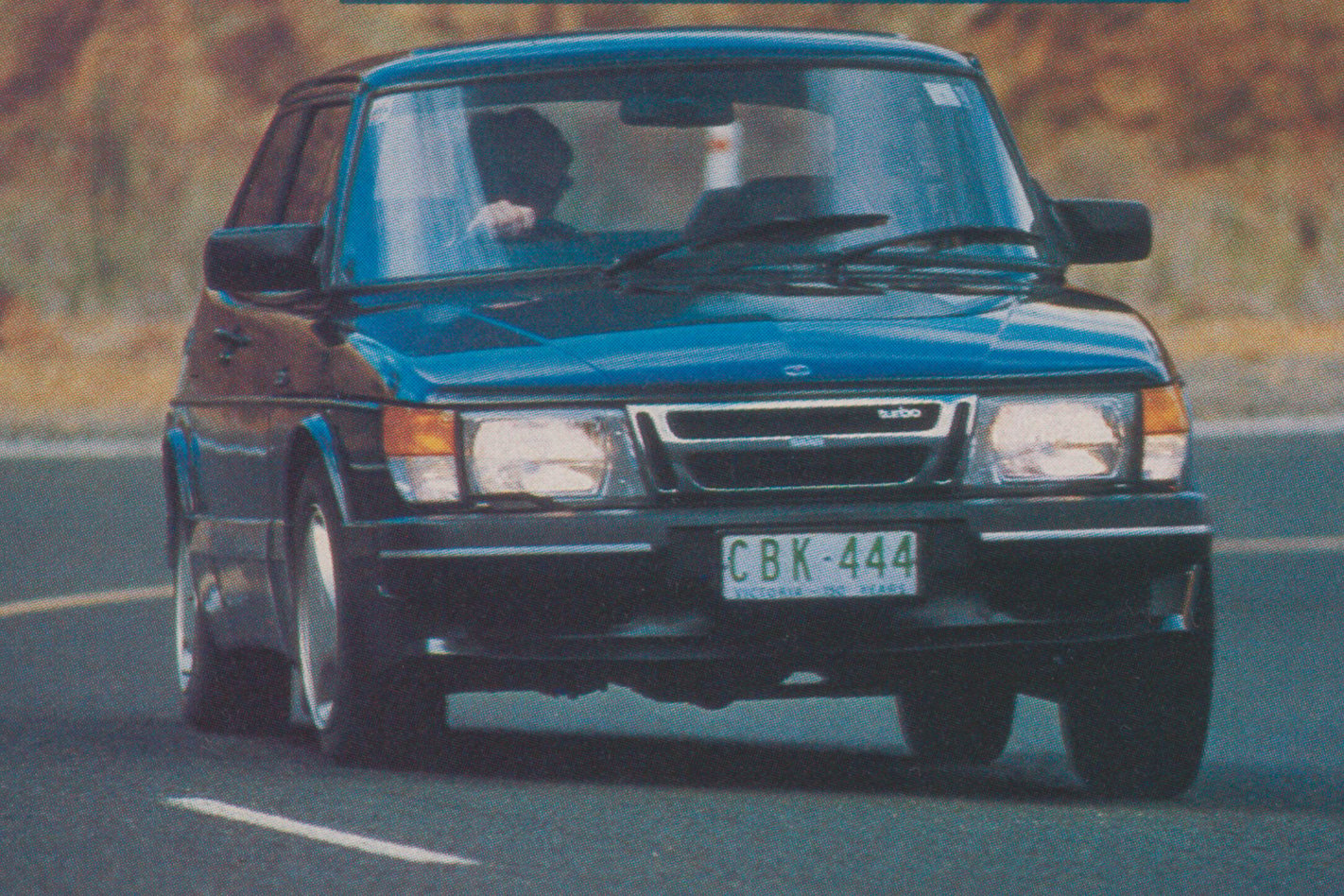
The 528i is somewhere between the Saab and the Commodore in its road behaviour. It is far firmer in its suspension than the Saab, at least so far as the ride is concerned, but appears to have more suspension travel than either. You could never call it supple, it is simply too firm for that, but it still has an ability to absorb bumps and keep them from the occupants. Initially the steering seems lower geared even than the Saab, however the driver soon discovers that the handling is so neutral that except in very tight conditions only relatively small wheel movements are required.
Like all BMWs the 528i, even with the stiff sports suspension and the LSD, will oversteer and wet roads need to be treated with respect. It is not a violent movement, as it was with the old car, for there is far too much inherent balance for that and the car is so easy to place on the road, and accurate, that even lifting off in the apex of a corner taken very quickly only tightens up the bend.

The Volvo’s dynamics are in many ways out of step with the others in this comparison. The engineers from Gothenburg had their priorities firmly planted in the ride department when it came to the 760 Turbo, for it is far softer than the others. Too soft, in fact, for many of the test team, who felt a sporting sedan shouldn’t display the body roll and lurchiness that comes naturally on the Volvo. Of course the ride is more comfortable and those people who want limousine qualities with turbo performance need look no further. In the extremes it lacks the precision and sensitivity of the others, though that won’t be considered a criticism by many who will discover the 760 is very easy to drive quickly and way beyond the point at which most Australians will long since have given up the chase. In the language of racing drivers, to about eight-and-a-half tenths.
It is in those last one and a half tenths that it begins to disappoint the true enthusiast. Change directions quickly in the Volvo and the body wallows, as if it is unable to keep up with the chassis. And the softness of the rear dampers leads us to the conclusion that this car was below par.
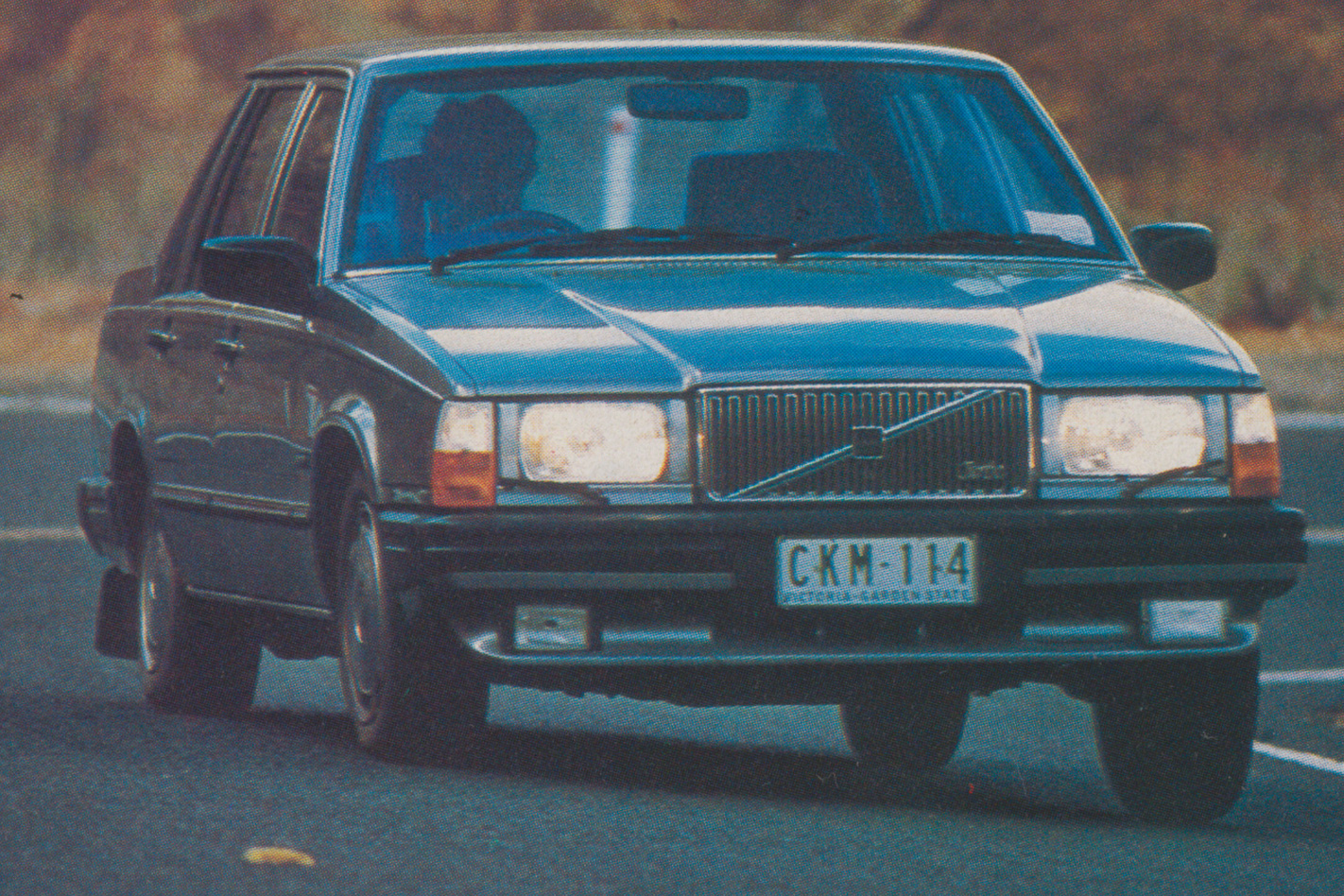
As a high speed cruise car the 760 is without equal in this foursome, but on tight twisty sections with undulating surfaces, it is possible to get the rear end skipping sideways, only momentarily we should add and in terms of mms rather than ems, and even bottoming out. From the driver’s seat the Volvo feels wider and generally bigger and does require more lock in any series of bends, where it feels to slide around and take up more road space even than the BMW and despite the 195 HR 60 Pirelli P6s. For all this it is very predictable in its behaviour and easy to drive, and quick too, so the compromise is logical for many people.
You expect nothing less than four wheel disc brakes with these cars and they deliver. The BMW goes one step further with ABS antilock system, yet in normal driving it is the 528i brakes which came in for the most criticism, with very poor pedal feel and the initial impression, which is shared with the Three Series, that the brakes aren’t going to stop the car. As part of the conversion from left to right hand drive, the brakes are operated by a torsion bar and it is the movement of this bar that creates this most disconcerting effect, and the subsequent grabbing sensation as the brakes suddenly go on very quickly. In a crash stop they work brilliantly, but not for the BMW driver the reassuring ability to dab the brakes lightly to set the car up before entering a corner.
The Saab’s brakes require a firm pedal but they are beautifully progressive and haul the car down from high speed with total stability. Those on the Group Three also work consistently and with even heavier pressure needed through a short pedal travel while the Volvo’s brakes are lighter, with longer travel and a slightly more spongy feel.
Where the European cars have it all over the Commodore is in the area of noise suppression for not only is the bent eight loud, but the Group Three has too much wind noise to be considered a true high-speed express in the European sense. In contrast the BMW, unlike the old Five Series, has least, but is still slightly behind the Volvo because its tyres give off such a pronounced hum, drone even, over coarse surfaces. The Saab isn’t as quiet with a whistle around the doors and some induction roar, but it is far less objectionable than the Commodore, which comes through as a machine for a three hour burst on a reasonably twisty section of smooth road.
Fuel consumption
The Group Three and 760 Turbo performed as expected, while the Saab and BMW surprised us with their frugal consumption. Obviously the Holden with its big lump of iron was going to use the most fuel, but given the manner in which it was driven, our overall average of 5.9 km/l (16.8 mpg) is at least acceptable and is probably a realistic everyday figure.
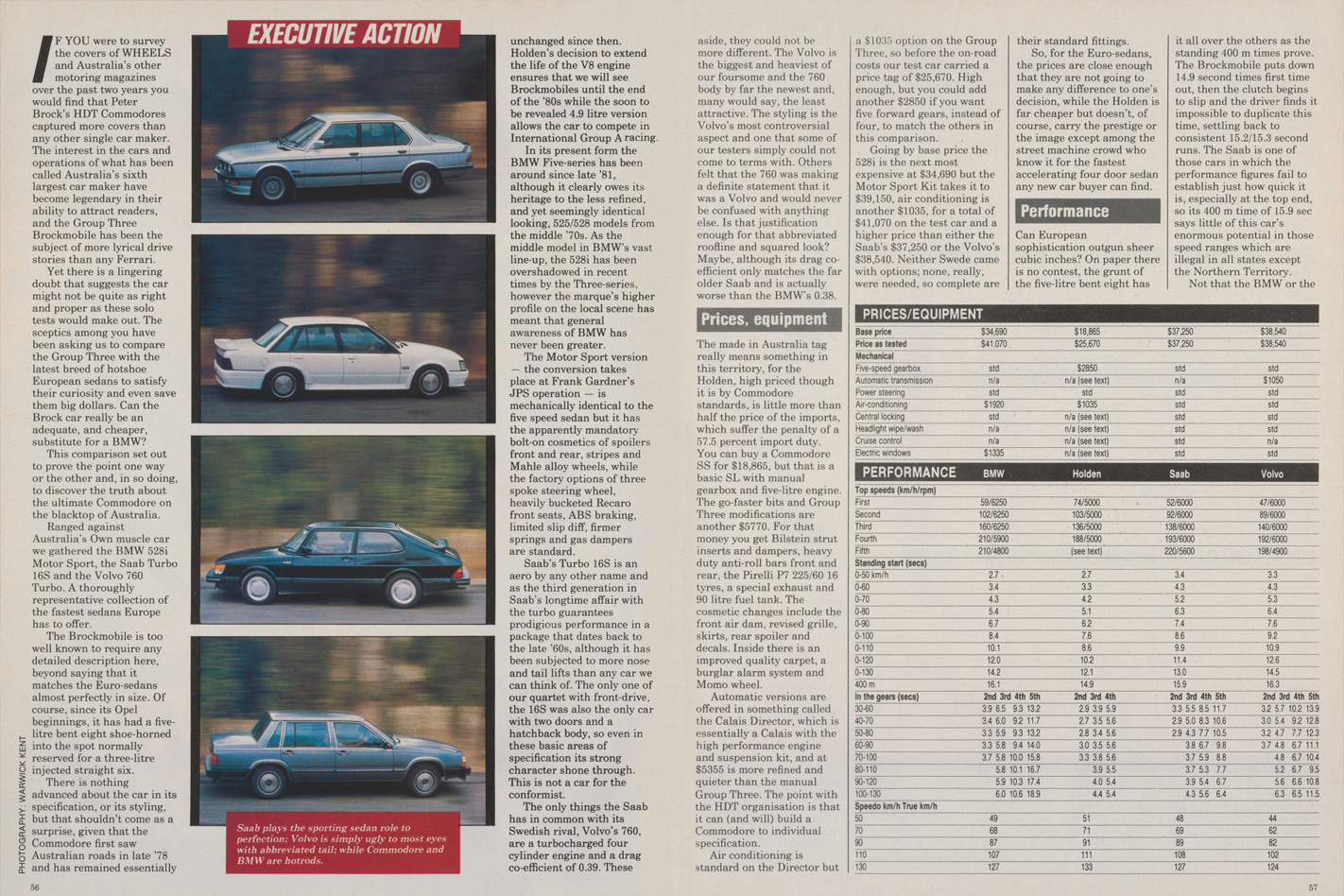
The BMW, (how much did that tall gearing help?) and Saab, with its much smaller, but turbo, engine, have virtually identical fuel consumption and their 8.6 (24.3) and 8.7 (24.7) respectively are outstanding given the performance levels. Where the Holden does lose out is in touring range, for despite the 90 litre tank it still is struggling to provide a 500 km range. Not so the Volvo or BMW, but the Saab could do with a few extra litres.
Accommodation
If you want to understand why the Commodore is at least $12,000 cheaper than the others a quick glance at the interiors will explain all. The Holden simply doesn’t have the quality feel, nor the equipment levels, of the Euro-sedans and is badly let down by the cheap and nasty instruments and the crudity of its controls. We understand the next Commodore takes care of these criticisms, but that doesn’t help this comparison, nor does it explain why the VK Commodore interior is a backward step from the VB.
The basic elements are there, the Scheel bucket seats, a full range of instruments, a leather bound steering wheel, even a four speaker sound system, but the finish is decidedly downmarket in this company and the quality of materials doesn’t match its rivals. In terms of space the Holden and Volvo are clearly more roomy than the BMW, while the Saab is even smaller, an impression supported by the two door body and relatively small glass areas. Yet all four are genuine four seaters with the Volvo and BMW our testers’ choice for an interstate trip with a full complement of passengers.
The Commodore’s wraparound Scheel bucket seats look the goods but aren’t in the same league as the Recaro seats in the BMW. There is plenty of lateral and shoulder support, but all our drivers complained of a lack of lumbar support, and that the cushion was too short and flat. There is a cushion height adjustment but no tilt as on the others.
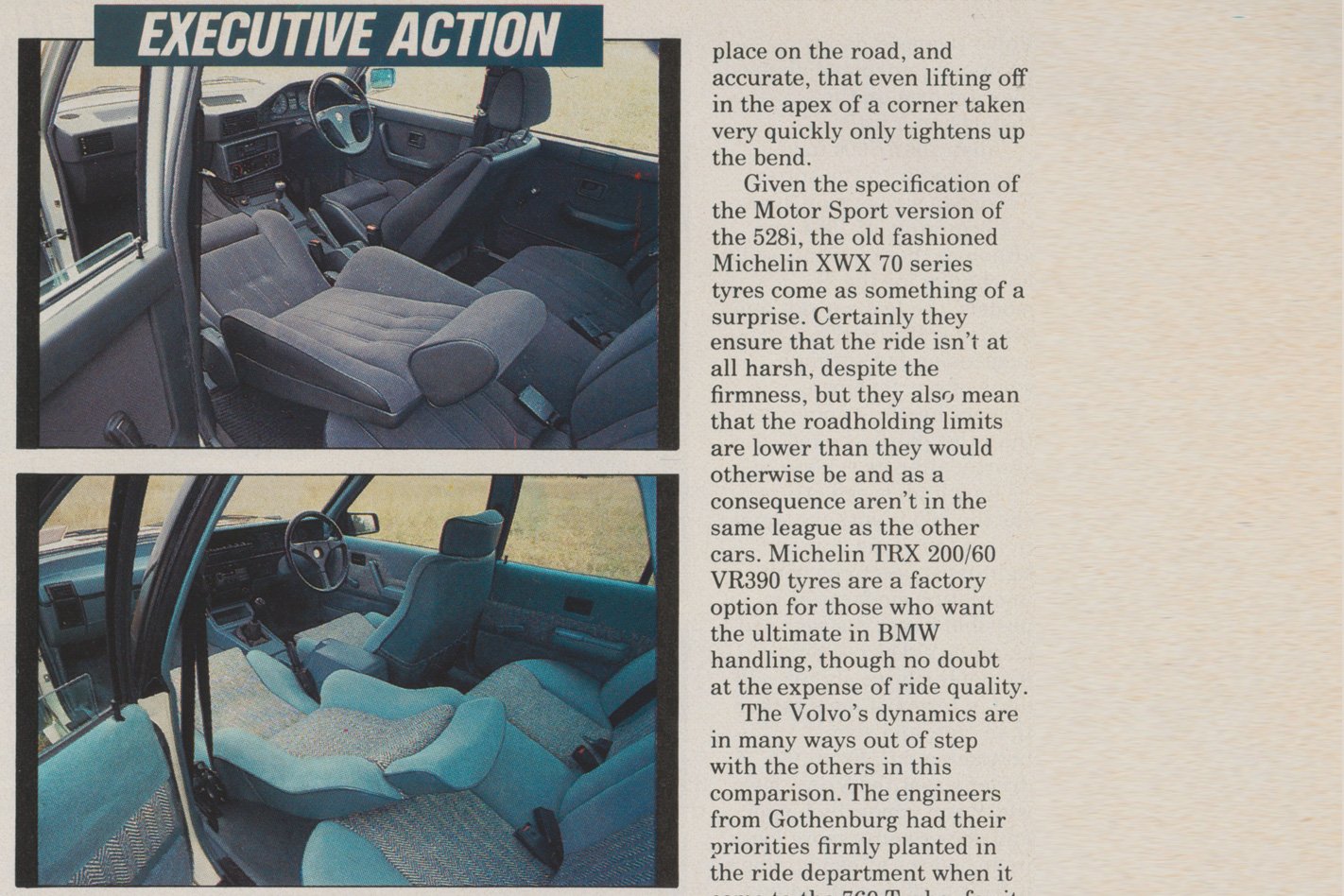
The Saab feels narrow and the scuttle high with shallow windows which reflect its now ageing body. But the ergonomics are excellent and virtually within finger tip reach of the driver except for the window controls between the front seats. The seats too, flatter than those of the Commodore and BMW, and lacking their lateral support, are very comfortable, front and rear.
The Turbo 760 shares its cockpit with the GLE automatic so it inherits the same rather flat and large bucket seats which still proved comfortable, while their excellent tilt arrangement provides a sufficient range of adjustment for a wide variety of drivers. There is heaps of room in the Volvo, in every direction, and even though the rear seat cushion is very high the extended roofline ensures there is plenty of headroom. The interior is a little too plasticky, but the controls are sensibly placed and the convenience of the long right-hand stalk for the wipers is outstanding.
Nothing comes near equalling the versatility of the Saab, with its huge load space and easy access through the hatchback tailgate. The BMW and Commodore have large, conventionally shaped boots, but the Volvo loses space because Australia gets the optional big fuel tank that sits on the boot floor.
How difficult and how ironic that all four cars should have significant failings. The Commodore is simply too noisy, too low geared and not in the same class when it comes to equipment levels and finish, and the ride, superbly controlled though it may be, is too firm for most drivers. Yet at full song, the stirring bent eight roar and the sheer, gutsy performance makes it a marvellous hotrod. Refined in a European sense it is not.
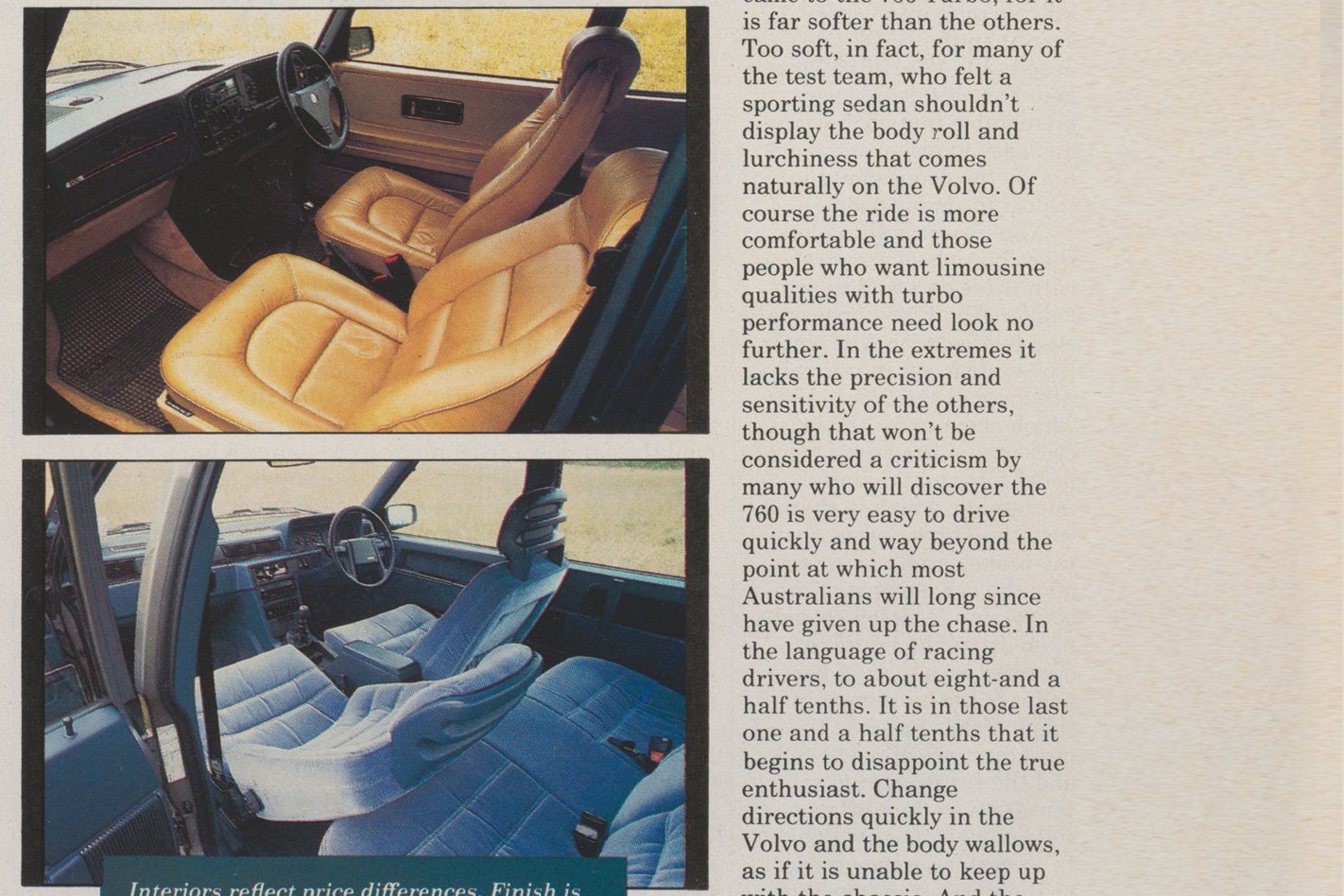
But we’re here to talk about sporting sedans and that leaves the BMW and Saab. The lack of bottom end torque and the general firmness of its controls and, of course, that absurdly tall gearing, count against the 528i on our roads, but given the lower gearing of the current car, and the precision, the seats, the finely balanced handling and the lovely six cylinder engine on song, would make us look very seriously at the BMW.
But we haven’t tested the new model and until then it is the Saab by a whisker in this fightout, even knowing that we would have to drive around bumps to avoid the groans from the body and accepting that the 16S does have a better gearchange. But the visual appeal of the Saab – it looks the part more effectively and yet with greater subtlety than the others – that staggering engine and roadholding and the body’s versatility would make it easy to live with, even if the occasional stumble at town speeds becomes annoying.

